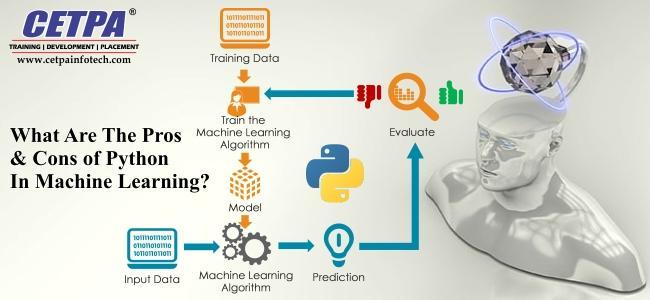What Are The Pros And Cons Of Python In Machine Learning?

If you’re reading this, you’re probably intrigued by the potential for machine learning to deliver incredible results for your business. But you might also be overwhelmed by how many ways there are to get started. If you’ve explored open-source tooling, it’s likely you’ve heard about the coding language Python.
Python is the most popular language in the world right now and it’s the de facto standard in coding for machine learning—and for a reason. Python has a long list of benefits. There are endless benefits of learning Python and one can join python certification online course for the same.
In this article, we’re going to discuss some of the pros of Python—why it’s uniquely equipped for the world of machine learning —as well as some of the challenges that relying exclusively on Python can present, especially in an enterprise environment.
PROS OF PYTHON FOR MACHINE LEARNING
EXTENSIVE LIBRARIES
Possibly one of the most significant benefits of Python web programming is the extensive libraries offered for development. It has libraries for everything, including string operations, web service tools, operating system interfaces, scientific programming, statistics, and computation.
FLEXIBLE PROGRAMMING
Python doesn’t follow a standard configuration and focuses on versatility in development. The learning curve is steep. It is a neat programming language with a clean code that allows utmost flexibility to Machine Learning programmers.
SIMPLE TO UTILIZE
Python is exceptionally readable and similar to the English language. It reduces the complexity in coding by providing clear and easily readable syntax to Python programmers. It helps in understanding the relationship between different objects and simplifies the entire Python web development life cycle.
OPEN-SOURCE AND EXTENSIVE COMMUNITY
One of the most significant advantages of Python software development is that Python is an open-source language. It is available for free and provides quick updates and releases from the community. Python’s code is updated frequently, which allows adding functionality to the Python applications. For learning Python one can join python online course.
CONS OF PYTHON FOR MACHINE LEARNING
WEAK NATIVE ENVIRONMENT
Python doesn’t interact well with naive components of the mobile operating system. This is why it is considered as a weak programming language for mobile applications. Android and iOS do not support Python for web development in their official programming language database.
LOW SPEED DEVELOPMENT
Python is not popular for its speed of development. It faces speed limitations because it is an interpreted scripting language. The compiled scripting languages like C, C++ are much faster than Python web programming. Therefore, it takes more time to develop an application.
RUN-TIME ERRORS
Because Python programmers don’t need to declare the type of variable, the design complications are much harder than you can think. It means that what Python code says is what the designs should be.
NO WEB BROWSER INTEGRATION
Python web development has high memory consumption, and since it is slow, it is not integrated with web browsers. Instead, there is Brython which is not suitable for real-world applications. Python doesn’t support running on a web browser and can hinder the speed of code execution if you try it.
Read More: Python Using Machine Learning Online Certification Course
CONCLUSION:
For the most part, Python web programming has turned out to be a big contributor in modern application development. Companies all over the world are using it for its exceptional machine learning and AI capabilities.
Python is an excellent option for most companies today because of the powerful functionalities it provides. But if you still want to explore other languages, Ruby on Rails is an excellent option.



